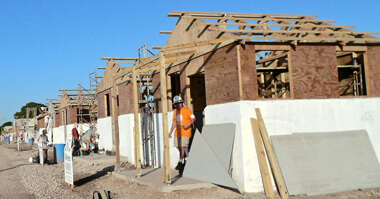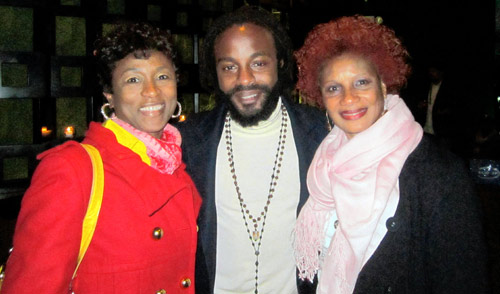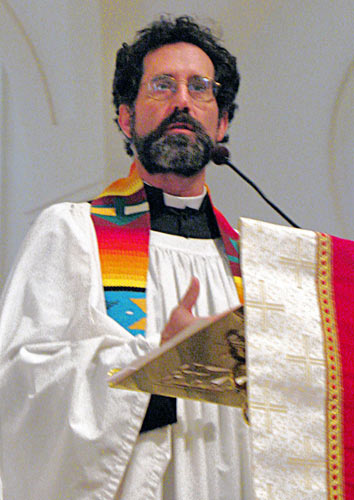“At first, I really didn’t want to go,” said Rodneyse Bichotte, whose day job in Corporate Development Mergers and Acquisitions at American Express and her other job as Democratic District Leader in the 42nd Assembly District in Brooklyn, a non-paid elected position, keeps her really busy.
“I’m on the Board of Habitat for Humanity-NYC,” Bichotte said. “ I am the Haitian Board member; I chair the Advocacy Committee.” Bichotte had to go! Her last trip to Haiti was two months after the earthquake in March 2010.
The Brooklynite returned to New York very happy, almost transformed, after one week of sweating while doing construction under Haiti’s sun at the Jimmy and Rosalynn Carter Work Project Build, an annual, internationally-recognized week of building simple, decent and affordable housing with and for families in need.
Four hundred twenty international volunteers raised $5000 each to build 100 homes for Haitians who lost everything in the earthquake. While some volunteers had been on many previous Habitat Builds, this was a first for Bichotte who has been involved with Habitat for over 20 years.
Construction took place in Santo, a neighborhood of Leogane, the earthquake’s epicenter–where 80% of the city was destroyed–about 16 miles south of Port-au-Prince.
“You’re working alongside these (new) homeowners, people who haven’t a home, there’s no agriculture, and they’re excited to have been selected to be a homeowner,” were reflections from Bichotte, who worked with a team of 10 volunteers on two houses during the five working days in Haiti.
All the volunteers boarded four chartered planes in Atlanta and were conveyed straight from the Port-au-Prince airport to the compound, accompanied by state police and security protection. The tent compound, a 20-minute drive to the work site, was their home for the week; volunteers were never off either of these sites.

Photo courtesy of Habitat.
Fifty Haitians with English language skills, bridging the linguistic gap, were roving translators between homeowners and other Haitian staff and the work teams. “By default, I was the translator for our teams,” Bichotte said, which made for good communication with the two Haitian women-recipients of the homes she worked on. Sheila, age 36, is the single mother of three children, ages 15, 12, and 5 and the other, Ginou, whose husband died in the earthquake, has two children, ages 2 and 9. The lucky 100 new homeowners, currently living under tarps or in tents, were chosen by community leaders; a lot of interviews were part of the process.
The homes are simple, two-room frame houses, on foundations that were built prior to the volunteer’s arrival. “I learned how to hammer better. What was really hard were the hurricane clips, metal plates used to connect 2×4’s together tight. It was hard to hammer,” said Bichotte of her newly gained construction skills. There is room in the back for an owner to expand the house (and also for a garden.)
Experienced Habitat volunteers found the Haiti homes quite different from other projects, particularly, no plumbing and no electricity. Solar panels are planned for each house in the future. One hundred fifty community latrines will serve the community.
A community center, school, health clinic and recreation field are also intended for construction. Wells are also to be built, roads improved, and a marketplace built.
The land, a former sugar cane field, was donated by the municipality, but up to a week before the Build was to begin, all the papers were not in order. The JC Work Project Build wouldn’t take place without the land deeds in-hand, Bichotte clarified. Haiti’s President had to intervene.
The annual JC Work Project Builds are massive undertakings, utilizing a thousand volunteers, but Haiti’s logistical challenges limited the number to less than half the usual. These Builds alternate national and international––a Katrina-impacted New Orleans was a previous Build. The Haiti mission is being extended another year because the need is so great and next year, another 100 homes will be built in the Santo community.
The plan is for Santo to hold 500 new homes. Including the construction of 55 homes prior to the Jimmy Carter Build by Haven, an Irish organization, come January, 150 houses will be ready for the families to move in.

Photo courtesy of Habitat.
During their week, living in a highly controlled and secure environment, volunteers saw little of Haiti–only glimpses through their bus windows, to and from the airport–through Carrefour on their way to Leogane, and what they could see of Haitian life during the back and forth from the home compound and to the worksite.
Haitian-born activist Ilio Durandis, who lives in Boston, was also a volunteer, sponsored by the Red Cross and a default translator on his work team. “I have mixed feelings,” he said on his return. “It’s good for the people receiving houses; they’re a lot better and are grateful,” he said, but knowing of the vast devastation, he voiced that Habitat could do more.
Jimmy Carter–building homes for more than 30 years–was in Haiti with his wife Rosalynn working on two homes, eating alongside and participating in sessions with the volunteers. Garth Brooks was also part of this Build. Mid-week, President Martelly visited the construction site.
At the end of the Build, Jimmy Carter visited every house for the celebratory dedication and photo, where each new owner was presented a bible and a cross, signed by those who helped build the house. Bichotte said, “It was an emotional moment. The new homeowners spoke (movingly) from the heart with great thanks. Everyone was teary-eyed.”
There was a waiting list to participate in this year’s Build. To work next year, one can get info and sign up on the Habitat website, www.habitat.org/cwp/2011/, remembering to raise $5000, which covers all transportation from Atlanta and in Haiti, accommodations and meals, and goes toward the construction costs.

Photo courtesy of Habitat.


















